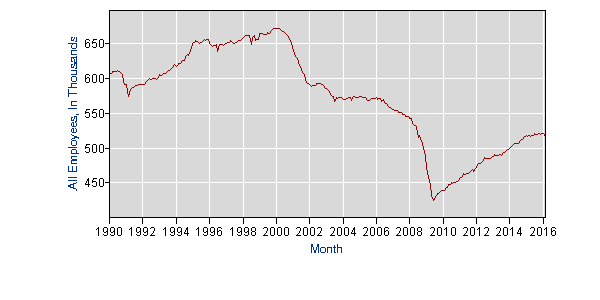May 05, 2016
It is bizarre how many people feel the need to claim that a large trade deficit in manufactured goods does not cost manufacturing jobs. You can argue all sorts of things about the merits of trade, and even make a story about how a trade deficit is good (pretty hard, when we’re below full employment), but it is almost impossible to tell a story that the explosion of the trade deficit between 1997 and 2006 did not cost manufacturing jobs.
Nonetheless that is the story the NYT gave its readers when discussing Indiana’s economy just before the primaries this week. It presents the views of Michael J. Hicks, director of the Center for Business and Economic Research at Ball State University in Muncie, Indiana:
“Factory jobs have declined, he added, but not because of trade deals with other countries as Mr. Trump and Mr. Sanders assert, but because Indiana factories are increasingly efficient and fewer workers are needed.
“‘Manufacturing employment peaked in 1973,’ he said, adding that since then the productivity of Indiana factory workers has climbed 250 percent. ‘We need far fewer workers, and a very different type of worker, too.'”
In the country as whole manufacturing employment peaked in the early 1970s, but then remained more or less constant, while falling as a share of total employment since the labor force grew. However employment fell sharply in the years from 2000 to 2006. While there was productivity growth in manufacturing over the years 2000 to 2006, that was also true for the years 1973 to 2000. The difference in the years 2000 to 2006 was the sharp rise in the trade deficit.
This was also the story in manufacturing employment in Indiana, as can be seen in the graph below.
Manufacturing Employment in Indiana

Source: Bureau of Labor Statistics.
As can be seen, manufacturing employment had been rising through the 1990s recovery. It peaked in December of 1999 at 672,200 and then fell to 556,700 by December of 2006, a drop of almost 20 percent. Employment fell further during the 2008-2009 recession, although it has recovered the ground lost. Anyhow, the data certainly seems to support the case that Indiana lost a large number of jobs due to trade in the years 1999-2006, it’s not clear why the NYT would want to deny this fact.







Comments